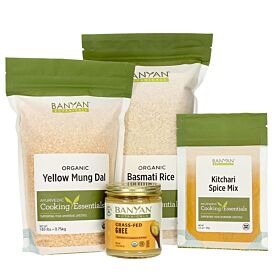Spring Cleanse for Kapha

Your body is remarkably intelligent and incredibly hard-working. Day in and day out, it processes all kinds of inputs—distinguishing what’s good for you from what’s not, doing its best to eliminate any harmful substances alongside routine metabolic waste.
But these days, our bodies are inundated with a never-ending barrage of stressors: environmental toxins, processed foods, unresolved emotions, and psychological stress, to name a few.
Inevitably, in attempting to “digest” it all, we accumulate some degree of toxicity—which, over time, can build up in the system, deposit in the tissues, and compromise our health. But there is something you can do to give your body a break.
Actually, this is precisely the idea behind an Ayurvedic cleanse: to slow the flood so that the body can rest, recuperate, and repair itself. And amazingly, when the deluge of inputs slows, your body will immediately take advantage of the lull to do some very deep cleaning.
The practice of cleansing is considered a vital part of an Ayurvedic lifestyle, with great potential for improved energy, strength, and immunity, as well as a renewed love of life.
An Ayurvedic cleanse rests and resets the digestive system, eliminates toxins, and simultaneously removes excess vata, pitta, and kapha from the body—all of which serve to promote improved balance and overall health.
Below, you will find everything you need to implement a simple, food-based cleanse at home this spring. However, even a gentle cleanse like this one is not appropriate for those who are pregnant or breastfeeding, or for anyone who is extremely weak or debilitated.
On the other hand, if you are considering becoming pregnant, it is ideal for both partners to undertake a cleanse approximately three months prior to conception.
What to Expect for Your Spring Cleanse
This particular cleanse is seven days in length, but plan on giving the process about two weeks for optimal results. This timeframe allows for proper preparation before the cleanse and eases you slowly back into your normal routine afterward.
A traditional Ayurvedic cleanse involves four distinct phases, each critically important to your success:
1. Preparation
Three Days Prior to the Cleanse (longer, if possible)
For a few days leading up to your cleanse, focus on cleaning up your diet and habits to prepare the body for an effective cleanse.
You will want to eliminate (or at least dramatically reduce) your use of coffee, caffeine, tobacco products, alcohol, and any recreational drugs. At the same time, reduce your intake of fast foods, processed foods, meat, refined sugars, and sweets.
During this time, eat as many simple, whole foods as possible (fruits, vegetables, whole grains, legumes, nuts, and seeds).
2. Active Cleansing
Core Seven Days of the Cleanse
This is the heart of the cleanse. During this time, you will eat a very simplified mono-diet of kitchari (basmati rice cooked with split mung beans). This diet is substantive enough that you can maintain your essential responsibilities, and it simultaneously resets the digestive system, supports the elimination of toxins, and balances vata, pitta, and kapha.
During this seven-day period, other cleansing practices such as abhyanga (Ayurvedic oil massage), gentle exercise, and detoxifying herbs can enhance the efficacy of the cleanse.
Further instructions detailing this phase of the cleanse are below.
3. Reintroduction
Three Days Following the Cleanse (longer, if possible)
Even after you complete the seventh day of the cleanse, your body will still be processing the toxins that may have been stirred into circulation.
Also, your digestive system will have become accustomed to a very clean diet and will be somewhat sensitive to overly stimulating or processed foods. Therefore, a slow transition back to a more diverse diet and back into your normal routine is critically important.
This three-day period is a chance to buffer your system and to rekindle your agni (digestive fire) so that it can handle more complex foods. Again, eat primarily simple, whole foods, diversifying your menu very gradually.
If possible, take this time to test the waters with foods that are potentially aggravating like dairy, wheat, and soy—ideally, reintroducing these foods one at a time and giving yourself up to 24 hours to observe how your body responds.
4. Rejuvenation
Up to Three Months Following the Completion of the Cleanse
This is the final step in any Ayurvedic cleanse. Now that you’ve cleared your body of accumulated toxins and imbalances, your tissues are primed to receive very deep nourishment. Rejuvenating foods and practices are usually sweet and comforting, and most people find this phase of the cleanse quite enjoyable.
If you’d like to know more about rejuvenation, check out our resource on spring rejuvenation.
Please Note: This timeframe is ideal, but if you don’t have two weeks to give to a cleanse, you can shorten the phases in proportion to one another. For example, you might do 1–2 days of preparation, 3–4 days of cleansing, 1–2 days of reintroduction, and 1–2 months of rejuvenation.
Planning and Preparation
The more completely you can clear your schedule for this process, the better. At a minimum, eliminate any unnecessary obligations and give yourself as much unscheduled time to rest as possible.
If you are menstruating, schedule your cleanse around your cycle to ensure that you are not bleeding during the 7 days of active cleansing. If your period comes unexpectedly, you can continue on the kitchari diet—but should suspend all other practices (abhyanga, nasya, triphala, etc.) until your menstruation is complete.

Daily Routine Tips for the Active Cleansing Phase
Freshly prepared foods are best for your cleanse, so you’ll want to cook your breakfast grains and kitchari fresh each day—at whatever time works best with your schedule.
While it is acceptable to prepare all of your food for the day first thing in the morning, you’ll want to avoid eating leftovers from previous days throughout the cleanse.
Morning Routine
- Rise early so that you can complete your morning routine before breakfast.
- Upon waking, scrape your tongue and brush your teeth.
- Administer Nasya Oil (3–5 drops in each nostril).
- Sip 8 ounces of hot water to cleanse the system and to awaken the digestive capacity.
- Perform abhyanga (Ayurvedic self-massage) with Organic Sesame Oil or Kapha Massage Oil.
- For maximum benefit, let the oil soak in for about 20 minutes.
- Do a steam bath, sauna, or improvised sweat.
- If you have access to a steam room or sauna, let your oil soak in as you sit just long enough to break a sweat.
- Otherwise, you can warm your bathroom with a space heater and create a little steam with hot water from the shower.
- It is important not to get chilled.
- Take a bath or shower
- Take care not to slip on oily surfaces—consider washing your feet first.
- If you have applied oil to your scalp, it can be helpful to apply and massage shampoo into the hair before wetting it and, if necessary, shampoo a second time.
- If you do not need to go out, it is fine to leave some oil in your hair.
- Use soap strategically (not all over the body).
- Excess oil will rinse off with water.
- Use a designated towel to pat dry (this towel will become oily over time).
- Make sure to clean your tub and drain using dish detergent on the tub or shower floor. Squirt some onto the surface and rub it around, following with water to rinse it down the drain. Do this every time you wash after abhyanga to prevent accumulation of oil.
- Make time for gentle exercise.
- Slow, gentle movements will support cleansing; more than that can be counterproductive.
- This is not a time to push yourself.
- Consider walking, tai chi, or qigong.
- Some gentle, Vata-Balancing Yoga (which is gentle enough for the cleanse) would also be perfect.
- Eat breakfast.
- Eat Seasoned Barley or Kitchari—as much as desired (do not overeat).
Throughout the Day
- Eat kitchari throughout the day, as desired.
- Eat at least 3 meals per day.
- Have more than 3 meals per day, if desired—allowing at least 3 hours between meals.
- It is best to avoid snacking, but if you need a little something extra, you can enjoy some fresh fruit or a few raw nuts.
- It is very important not to feel deprived during your cleanse.
- Be sure to eat enough food and enough variety that you truly feel satisfied and at peace with this process.
- You can garnish your kitchari with Fresh Coriander Chutney or Sesame Seed Chutney.
- Try not to eat after 7 p.m.
- Drink plenty of room temperature, warm, or hot fluids each day to ensure adequate hydration and to help flush toxins as they are released (a good rule of thumb is to divide your weight—in pounds—by two and drink at least that number of ounces each day: e.g. 150 pounds ÷ 2 = 75 ounces).
- Ideally, most of your fluids should be taken between meals.
- Appropriate fluids include water, Ginger Turmeric Tea, Rehydration Tea, and detox tea—drink as much of these as you like.
Evening Routine
- Drink triphala tea.
- About half an hour before bed, steep ½ teaspoon Triphala powder in a cup of freshly boiled water for 10 minutes, cool, and drink.
- Or, take 2 Triphala tablets with a glass of water.
- Retire for the night.
- Sleep is the body’s best time to detox so be sure to get plenty of rest during the cleanse.
Making Supportive Lifestyle Choices
- Keep your activities as quiet and mindful as possible.
- Surround yourself with things that you find uplifting and nourishing.
- Minimize stress and exposure to frantic or disturbing environments.
- A cleanse can stir up unresolved emotions so it is important to be prepared for some emotional purging as well. If intense emotions arise during or after your cleanse, greet your emotions with compassion, observe them with detached awareness, and allow them simply to move through—honoring yourself in the process.
- REST as much as possible. You can ensure that the bulk of your energy is devoted to cleansing by minimizing the number of resources that your body allocates elsewhere.

Transitioning Back Into Your Normal Life
Toward the end of the cleanse, take some time to reflect on your life so that you can move forward with whatever new intentions feel important to you at this time. One of the greatest gifts you can give yourself as you wrap up your cleanse is to honor the effort you’ve made by slowly and gently easing back into a more diverse diet and a more typical routine.
Even after you’ve moved through a defined period of reintroduction, understand that it may take some time—two weeks, a month, or longer—before you are able to fully appreciate the benefits of your cleanse. The body is often still working to eliminate the toxins released during the cleanse, so this is completely normal.
It is really important to cultivate inner awareness and to listen to your body as you transition into a more diverse, but healthy, diet and lifestyle. As you do this, you can move into the final phase of the process—known in Ayurveda as rasayana or rejuvenation—a period of time to offer your tissues deep nourishment.
Recipes
These delicious recipes have been provided courtesy of Dr. Scott Blossom. Remember that your food will absorb the energy of your mindset and state of being while cooking, so you can assist your healing process by bringing good intentions and a sense of presence to your kitchen.
- Seasoned Barley
- Kapha-Reducing Kitchari
- Fresh Coriander Chutney
- Sesame Seed Chutney
- Ginger Turmeric Tea
- Alakananda Ma’s Rehydration Tea
Shopping List
-
Herbs & Products
- Organic Sesame Oil or Kapha Massage Oil
- Nasya Oil
- Triphala Powder or Triphala Tablets
- Tongue Cleaner
- Brahmi / Gotu Kola (optional)
- Kapha Digest (optional)
-
Groceries
- Organic White Basmati Rice, about 3 pounds
- Organic Yellow Split Mung Beans or Organic Whole Mung Beans (available in the bulk section of most health food stores), about 1½ pounds
- Organic Ghee (Clarified Butter—available at most health food stores)
- Organic Roasted Sesame Seeds (optional)
- Kombu or Wakame (optional) (available at most health food stores)
-
Vegetables such as
- Burdock Root
- Zucchini
- Green Beans
- Leafy Greens (Kale or Collard Greens)
- Onion
-
Spices and Garnishes to Consider Having on Hand (for the above recipes)
- Bay Leaves
- Brown Mustard Seeds
- Black Pepper
- Cayenne Pepper
- Cilantro
- Coconut, Unsweetened and Shredded
- Coriander Powder
- Coriander Seeds
- Cumin Seeds
- Fennel Seeds
- Ginger Root, Fresh
- Lemons
- Limes
- Fresh Mint or Dried Peppermint
- Oregano
- Sage, Dried
- Natural Mineral Salt
- Sweeteners: Raw Honey (best choice for kapha), and/or Turbinado Sugar
- Turmeric Root, Fresh (optional)
- Turmeric, Powdered
Or, save time and money with one of Banyan’s Cleanse Products:
-
Kitchari Kit
- 7-day Supply of Organic Basmati Rice
- 7-day Supply of Organic Split Mung Dal
- Kitchari Spice Mix
- Organic Ghee
-
Cleanse Bundle
More versatile than the Kitchari Kit—convenient and customizable!- Seven-day supply of Organic Basmati Rice
- Seven-day supply of Organic Yellow Mung Dal
- Kitchari Spice Mix
- Organic Ghee
- Organic CCF Tea
- Total Body Cleanse tablets
Additional Resources
For a more in-depth resource, visit Banyan’s guide on Ayurvedic cleansing. You can also download this free Ayurvedic Cleanse E-booklet.
There are a number of different approaches to cleansing. You may find that a short digestive cleanse or a simplified three-day kitchari cleanse would be more supportive for you.
Panchakarma is one of the better-known methods and is a more extensive form of Ayurvedic cleansing than the gentle, food-based home cleanse discussed here. While panchakarma offers profound benefits, it requires a more complete withdrawal from daily activity and should only be performed under the guidance of an experienced Ayurvedic practitioner.











